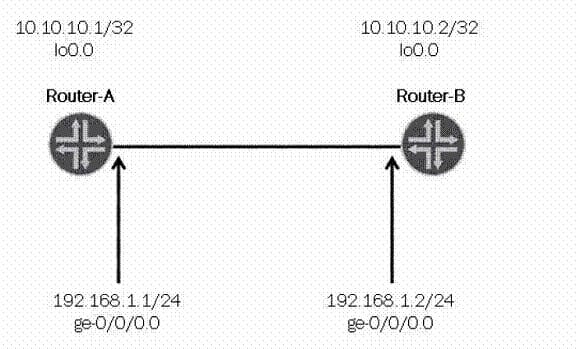Exam Details
Exam Code
:JN0-343Exam Name
:Juniper Networks Certified Internet Specialist (JNCIS-ENT)Certification
:Juniper CertificationsVendor
:JuniperTotal Questions
:563 Q&AsLast Updated
:Jun 29, 2025
Juniper Juniper Certifications JN0-343 Questions & Answers
-
Question 351:
A GRE tunnel is established between two routers. When a user on one end sends traffic with a large packet size to a user on the remote end, the packet never arrives. However, the problem does not exist for smaller packets. What is the problem?
A. The tunnel is down on the remote end.
B. The don't-fragment bit is set on the traffic.
C. GRE tunnels do not support IP traffic.
D. No dynamic routing protocol exists to handle the traffic.
-
Question 352:
A company's Junos-based router has two EBGP peers and receives two BGP update messages with the following information:
Peer A - AS path [ 65001 64513 12 ] ; MED 67 ; origin value 1
Peer B - AS path [ 65002 64513 12 ] ; MED 70 ; origin value 2
Assuming default values, how will the company router react to these updates?
A. The path through Peer A will be preferred for all traffic to that destination.
B. The path through Peer B will be preferred for all traffic to that destination.
C. The paths will be load balanced to that destination based on a Layer 3 hash.
D. The company router marks the routes as hidden to that destination because the MED exceeds 63.
-
Question 353:
Layer 2 interfaces can be assigned to operate in which two modes? (Choose two.)
A. route
B. access
C. trunk
D. distribution
-
Question 354:
You have created an IP-IP tunnel which will traverse interface at-0/1/0 and you would like to make sure that the tunnel is operational. Which operational-mode command should you use to verify that the IP-IP tunnel interface is up?
A. show ip tunnels interfaces
B. show interfaces at-0/1/0 terse
C. show interfaces ip-0/0/0 terse
D. show ip-0/0/0 interfaces terse
-
Question 355:
What is a difference between a generated route and an aggregated route?
A. Generated routes have a higher preference by default.
B. Generated routes use a next hop of discard.
C. Generated routes have a lower preference by default.
D. Generated routes use a next hop of a contributing route.
-
Question 356:

In the exhibit, how many Level 1 adjacencies does Montreal have?
A. 2
B. 3
C. 4
D. 5
-
Question 357:
Which two packet types are handled solely by the RE within an EX4200? (Choose two.)
A. OSPF hellos
B. DHCP relay
C. STP BPDUs
D. IP multicast traffic
-
Question 358:
Which statement describes an OSPF area for which no-summaries is configured?
A. The ABR does not generate any Summary (Type 3) LSAs towards the backbone.
B. The ABR does not generate any Summary (Type 3) LSAs for other OSPF areas.
C. The area does not summarize external routes generated within its area.
D. The area does not accept or create summaries of any kind.
-
Question 359:

Router-A and Router-B shown in the exhibit are peering between their loopback interfaces. Which operational command on Router-A do you use to display all the BGP routes received from Router-B?
A. show route receive-protocol bgp 10.10.10.2 all
B. show route receive-protocol bgp 10.10.10.1 all
C. show bgp rib-in neighbor 10.10.10.1
D. show bgp receive-protocol bgp 10.10.10.2
-
Question 360:
You want to change the BGP next hop to ensure that internal routers have reachability to networks learned from external peers. Which configuration excerpt applied on the perimeter router achieves this objective?
A. protocols { bgp { group internal { type internal; local-address 10.10.10.1; neighbor 10.10.20.1 next-hop-self; neighbor 10.10.30.1 next-hop-self; neighbor 10.10.40.1 next-hop-self; } } }
B. protocols { bgp { group internal { type internal; local-address 10.10.10.1; export change-next-hop; neighbor 10.10.20.1;
neighbor 10.10.30.1;
neighbor 10.10.40.1;
}
}
}
policy-options {
policy-statement change-next-hop {
term 1 {
from {
protocol bgp;
external;
}
then {
next-hop self;
}
}
}
}
C. protocols { bgp { group internal { type internal; local-address 10.10.10.1; export change-next-hop; neighbor 10.10.20.1; neighbor 10.10.30.1; neighbor 10.10.40.1; } } } policy-options { policy-statement change-next-hop { term 1 { from { protocol bgp; route-type external; } then { next-hop self; } } } }
D. protocols { bgp { group ext { type external; export change-next-hop; peer-as 111; neighbor 10.10.20.1; } } } policy-options { policy-statement change-next-hop { term 1 { from { protocol bgp; } then { next-hop self; } } } }
Related Exams:
JN0-102
Internet Associate, Junos(JNCIA-Junos)JN0-104
Junos, Associate (JNCIA-Junos)JN0-105
Junos, Associate (JNCIA-Junos)JN0-1101
Juniper Networks Certified Design Associate (JNCDA)JN0-1103
Design, Associate (JNCIA-Design)JN0-130
Juniper networks Certified internet specialist.e(jncis-e)JN0-1301
Data Center Design, Specialist (JNCDS-DC)JN0-1302
Data Center Design Specialist (JNCDS-DC)JN0-1331
Security Design, Specialist (JNCDS-SEC)JN0-1332
Security Design, Specialist (JNCDS-SEC)
Tips on How to Prepare for the Exams
Nowadays, the certification exams become more and more important and required by more and more enterprises when applying for a job. But how to prepare for the exam effectively? How to prepare for the exam in a short time with less efforts? How to get a ideal result and how to find the most reliable resources? Here on Vcedump.com, you will find all the answers. Vcedump.com provide not only Juniper exam questions, answers and explanations but also complete assistance on your exam preparation and certification application. If you are confused on your JN0-343 exam preparations and Juniper certification application, do not hesitate to visit our Vcedump.com to find your solutions here.